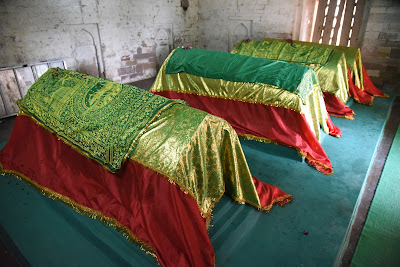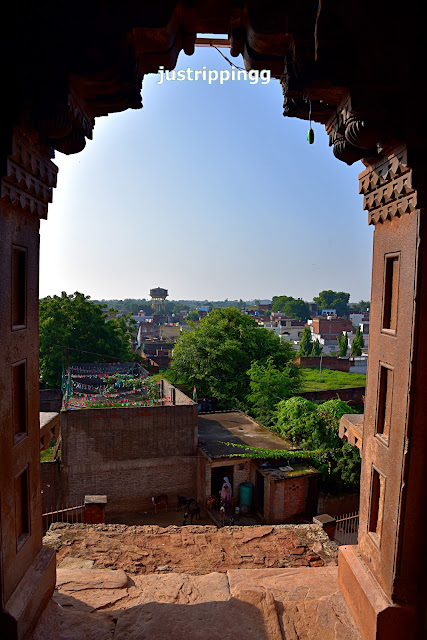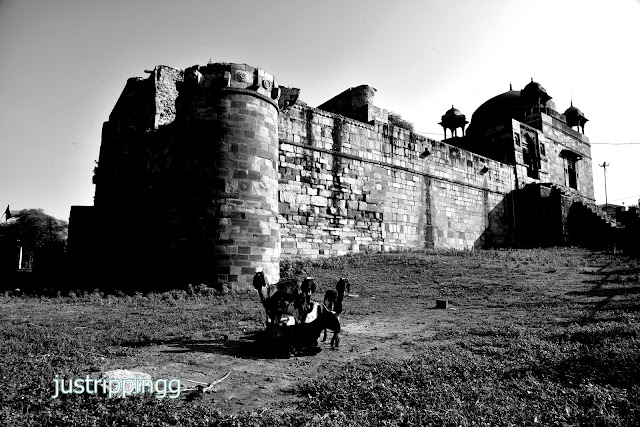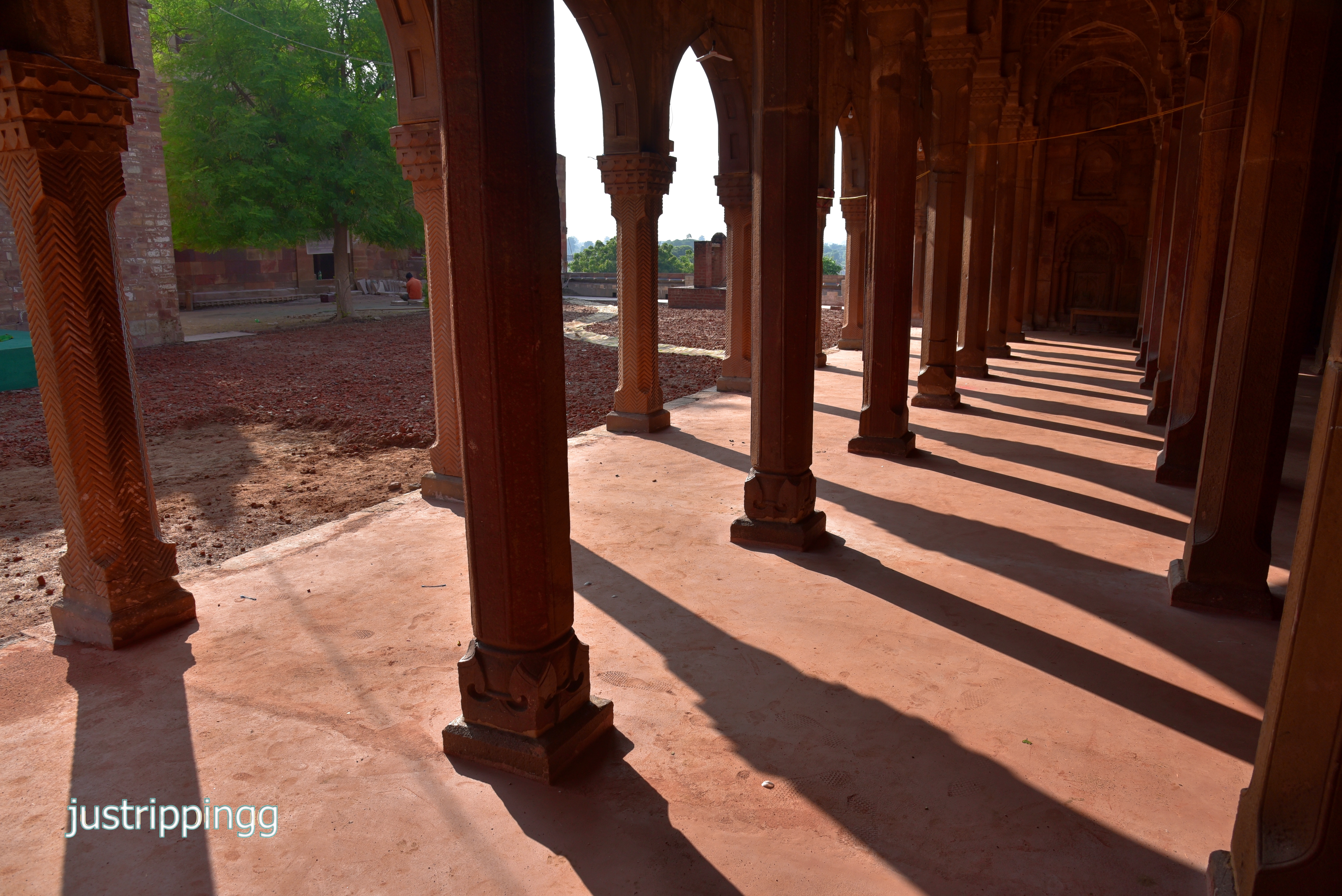The Veil Lifts – just a wee bit
You feel for Alexander Cunningham and all other archeologists. An entire century worth of history is wiped clean off from the banks of Ganga in this center of India’s golden period. It is not easy to comprehend why these invaders from Central Asia would turn this mad and destructive as soon as they crossed the Indus. While physical remains of earlier dynasties and rulers would largely remain intact from Mediterranean to Bamyan (until recently), here, the Ganga plains would witness the full wrath.
 |
Kannauj - The Shadows of Time |
 |
That's 2000 year history stratigraphy right there - at Bala Peer mound in Kannauj |
In a memorandum, Colonel A Cunningham, of Engineers, wrote about his proposed investigation of archaeological remains in Upper India. The tour would follow the footsteps of Chinese pilgrim Hwen Thsang, who in the seventh century traversed India from West to East and back for the purpose of visiting all the famous sites of Buddhist history and tradition.
 |
You can always correlate the majesty of the lost temples from the surviving images and the workmanship on this panel is breathtaking - Saptamatrika, 9th Century, Kannauj, Kannauj Museum |
“Kanouj – no account of the ruins of this once celebrated capital has yet been published. Several ruins are known to exist, but it may be presumed that many more would be brought to light by a careful survey of the site.”
Alexander Cunningham made two tours of Kannauj in 1838 and 1862. He
probably thought he could be luckier in the second visit but regretfully he was
still unable to discern any meaningful narrative of Harsh’s kingdom in the
aftermath of Ghazni’s total annihilation. The second time around even the
images on the pillars had been obliterated. He could only conjecture the
locations of the two great Ashokan stupas among the numerous mounds in the
area. So, what happened to the stups and vihars and temples – you have surmised
your theory in the earlier post and will further expound on it here.
 |
The spanking new Agra-Lucknow Expressway |
 |
Kaas Flowers in the Ganges |
A brief list of tasks to complete was mentioned at the end of a Kannauj
post you wrote in the beginning days of the first lockdown in 2020 - Visit
Kannauj, Badaun and Jaunpur. The visit might help you lift the mists of time
over the glorious city of Kannauj. The year 2022 turned out to be good and you
were lucky to visit several places in the still unexplored Uttar Pradesh after
a long gap. You spent few hours in Kannauj and about a day in Badaun and
finally you are making some sense of this big blind spot of Kannauj in our
history’s golden period.
 |
Kannauj Map with four main sites - Jama Masjid, Balapeer, Jaichand Fort and Makhdum Jahaniya |
 |
You know you are entering the Ittar Nagri of Kannauj |
Early morning, you hail a local auto manned by a smiling Shahid and we are on our way through the winding lanes to the Masjid whose painting by the Danielles first got you interested in Kannauj. The topography as we hurtle through the narrow lanes of Sekhana locality is definitely not like that of a town in the Gangetic plains. The last stretch of the concrete track is a steep uphill gradient ascending to the Sayid Jalal Makhdum Jahaniya Mosque & Tomb built in 1476 by Husen Shah of Jaunpur's Sharqi. Soon he would be pushed out of Kannauj by Bahlol Lodhi.
As you stand on the top in the mosque complex looking down at the town below, Henry Cousens remarks come to life. This is certainly the highest point of the town which would have had the flagship temple. For the Sharki kings, Cunningham muses in 'Report of Tours in the Gangetic Provinces' - "The architecture of Jaunpur is confined almost entirely to these Muhammadan mosques, for the Sharki kings who were such great builders were equally, great destroyers, as every masjid was reared on the site of a Hindu temple." So yes, Kannauj does offer you something that could tie up the historiography beginning from the early first millennium.
 |
The Makhdum Jahaniya Mosque and Tomb |
The monument is getting some conservation treatment. And before you realise it you get into the customary kerfuffle with the supervisor. At ASI monuments, you are free to vandalise them, paint graffiti, climb over them, litter, have a drinking session, guards will simply ignore you, but the moment they see a camera they turn into a local Changez Khan. There are days, like this morning, when you wish you could just go Khilji on this local Mongol; like he did at Chor Minar on the Mongols.
 |
52 Pillar Mosque or Makhdum Jahaniya Mosque, Kannauj |
 |
Some four hundred years later |
 |
The mihrab and the beautiful muqarnas in the corners above |
You are slowly taking it all in. You have just climbed some steep steps
and enter the sprawling mound forty feet high through this southern ornate
gateway. Along with the mosque there are three tombs in the complex. In the
early morning light, the mosque looks a lovely golden. The central dome that
still existed when Daniells painted it is missing now – or did the Daniells
take some artistic liberty? The mihrab, especially the muqarnas, the pillars
and their capitals are all beautifully ornamented though unlike other ghurid
mosques, the pillars do not carry any Hindu motifs. A pretty gate leads to the
south-west corner that has three graves. You have a feeling that this too was
surmounted by a roof if not a dome but is now missing. A well sits in the
courtyard that still has the original wood pulley surviving.
 |
Graves of Makhdum Jahaniya and his descendants |
Facing the mosque are three tombs. Nearest tomb has the grave of Makhdum Jahaniya and three others of his descendants. All three tombs are square in feature and quite plain looking. The north east corner of the mound is unpaved and the ground is spilling with brick pieces. You would love to sit here and listen to the bricks as they tell you the stories of long ago when Hieun Tsang would come here occasionally to watch the sun set over Choti Ganga. Was this the site of one of the two magnificent temples he wrote about? The bricks have seen it all. They have all the answers.
Cunningham says the two images built into the entrance steps were missing on his second visit. He does get angry when he sees all this destruction and in this foul mood he fails to appreciate the beauty of the mosque. In Jaunpur, he knew there were no stups so he was quite circumspect and even agreed with Fergusson that Atala Masjid was the most ornate and beautiful. But here in Kannauj, finding no traces of stups in a major Buddhist city, Cunningham is uncharacteristically sullen and not thinking like an archaeologist. He is sure the tablets and cords in the qibla wall have been chiselled out of temple bells and chains. But you are not sure. It has been almost four hundred years since the temple was brought down. You are not sure if the original pillars and temple elements have survived this long. The pillars do not look repurposed and are missing the usual motifs. You are not sure about the pillars in Jama Masjid which you could not see - Fergusson is sure the cloisters are all from temples. Does the contemporary Atala Mosque in Jaunpur has temple pillars? That wait for visit to Jaunpur is getting long.
Despite best efforts and two tours, Cunningham is only able to guess where those two Ashokan stups could have been. It is always special to be following Cunningham’s footsteps and you are equally distraught that absolutely no traces of Magnificent Kannauj survive: so total is the annihilation by the friends from Afghanistan, Delhi and of course time. Cunningham continues to snipe in 'Report of Tours in the Gangetic Provinces' - "There is not at present a trace of any old Hindu temples standing, for the Muhammadans did their work of destruction with unusual completeness."
-------------------------------------------------
-------------------------------------------------
 |
The Jaichand Fort in Kannauj |
 |
Old Fort or Jaichand Fort in Kannauj |
Next stop is Jaichand’s Fort. We have all heard of his treason when he refused to come to Prithviraj’s aid and rest is ignoble history. Jaichand is one of the infamous names in Indian history but then you are sure there were many of his tribe across the country across the ages into the present. How is it possible for the few invaders to just roll over all these brave and legendary kings in the span of a few decades? Yes, nobody wants to ask these questions. The city is just a group of mounds and this fort continue to be a great mound of unbuilt-over mud. Just looking at the cross-section of the walls you can see two thousand years of history.
The other mosque, Jama or Dina Masjid is deep inside the settlement and again built over a tall mound – perfect spot for the second temple where Cunningham
reports that the hypostyle architecture has been remodelled to a single deeper
prayer hall. The iron sliding door is closed. These are sensitive times. You don't probe and return to the auto.
 |
The whitewashed Jama Masjid in Kannauj, UP |
The city is like a roller coaster. And here we go again as the auto rickshaw huffs and puffs its way to the top of another mound. You walk through a tall gateway into the compound of Bala Peer ka Maqbara. It is surprising that Cunningham does not provide description of the twin tombs set on a high platform. Maybe he just got disgusted with not finding the temples so he set out to look for stups and vihars in the neighbourhood outside the fort walls. As you walk towards the platform you can see walls of bricks with stone cladding – ancient walls with medieval treatment. You are again on top of this mound offering more views of the city and the possible old fort with its walls that would have run around these group of mounds.
 |
ASI Monuments in Kannauj, Agra Circle |
 |
The entry gate to Bala Peer Maqbara Complex built on a mound |
 |
Bala Peer ka Maqbara in Kannauj UP |
 |
The beautiful paintings in the smaller tomb, Balapir, Kannauj |
The two tombs set on a platform look similar to the Makhdum Jahaniya tombs. Conservation work is going on here too as you manage to click the paintings in the second tomb. The Bala Peer is perhaps Sheikh Qasim Qadri as reported in one youtube video. Clouds gather in the skies. Some goats have made their way up on the platform as they too want to enjoy the breeze and the views. On the North you can see the ruined dome of Hazrat Syed Bajariya Shah Rauza. Makhdum Jahaniya can be seen towards south-east.
 |
The mound of Bala Peer Maqbara, Kannauj |
Here is a theory on what could have happened in Kannauj:
How would the city look when Hsieun Tsang was here with thousands of monks and a kingdom at its zenith? The Chinese itinerant also notes the presence of two Hindu temples – dedicated to Surya and Maheshwar. The museum has multiple images of Surya and a delectable stele of Uma-Maheshwar. It is unlikely the temples were built on top of stups, as conjectured by Cunningham in Mathura. So where did all the Buddhist remains disappear? The likely explanation is the emergence of Brahminism in the intervening period of about 400 years before Ghazni arrives carrying the sledgehammer.
While Sanchi probably got saved by the desertion and vegetation providing cover, here in living Kannauj, the remains of stups and vihars were probably simply dismantled, repurposed and used as building material by the locals as Buddhism waned. You have seen that in random villages across the country. If you have visited a monument recently you can see for yourselves how we love to vandalise and brutalise them. Four hundred years is a long time for these unloved monuments. The stups and monastery complexes turned into mud mounds. Assorted temples, dargah and shrines came up on the mounds. While Hindu and Jain broken images have been found, very few Buddhist sculptures have been unearthed.
There is an additional period of about 500 years between the complete destruction of temples by Ghazni in 1018 and the construction of mosque in 1476 by the Jaunpur Sharqis. Most of the temple elements would have been lost or rendered unusable except for few broken pieces of images and other detritus. And therefore much to Cunningham's shock and dismay, nothing has survived of Kanyakubja.
 |
This is Shahid and your ride for the morning |
 |
The famous Kalawati Gatta Bhandar in Kannauj |
Let us come back to current times. Harshvardhan has been forgotten, the stups and temples are gone. It is the perfumes that are synonymous with the town now. Shahid will drive you through Bara Bazaar to look at a few shops selling perfumes and ittar; if they are open at this early hour. No you don't buy any.
 |
Ittar retail shops in Bara Bazaar, Kannauj |
 |
An Ittar manufacturing unit in Kannauj |
Kannauj - Window to the Past
The last stop is the Government Archaeological Musuem. You are hoping for the best. The Mathura Museum was a total surprise and delight. You are looking for some redemption here. The Kannauj Museum too has been beautifully put together. It is a miniature of Mathura Museum. Most of the exhibits are housed in glass cases tracing their lineage from the early times to Shunga and then the later dynasties. The yellow sandstone Uma Maheshwar image is pure love-song Gahadwal style. Harshvardhan’s story is depicted in the diorama section along with the customary perfume making process.
 |
The amazing Whistling Yogini on Owl, 11th Century Kannauj, Now in San Antonio Museum, USA |
 |
Dioramas depicting life of Harshvardhan |
 |
Dioramas depicting making of Ittar |
You are not sure what to make of the exploration so far. Kannauj of Harshvardhan and Hsieun Tsang has definitely faded away into oblivion. In a town where Hsieun Tsang would spend seven years, a town with lofty stups & vihars, except for the scattered mounds, some brick walls, broken images and the medieval mosques & tombs, nothing notable survives. Cunningham’s continued indignation and frustration is justified. The destruction is thorough and total. By his second visit even the images on the walls of the mosque have been destroyed. For an archaeologist, there are no strands to plot the historiography of North India’s greatest kingdom.
 |
Kannauj - The City of Mounds |
 |
And the Ganga Flows - Looking East towards Ganga from Makhdum Jahaniya |
You are sure the mighty kingdoms over the ages did not fight over these mud mounds. The stakes would have been lot higher that would attract Ghazni to Kannauj after burning down Mathura. The question is why was Mathura able to resurrect from its deathblow while Kannauj would sadly turn to mud and pieces of bricks and then disappear in the sands of Ganga riverbanks?
Things to see on your next visit to Kannauj
Jama or Dina Masjid ‘absurdly’ called Sita ki Rasoi - Cited by Fergusson as a specimen of Hindu cloisters. Cunningham notes that the mosque had three cloisters when he first visited in 1838 – a typical Ghurid hypostyle template inspired by Qutb complex. By 1862, the mosque had been remodelled. Now only the main prayer hall exists; the two rows turned into four rows of pillars. Also, all traces and images of temples have been obliterated from the walls.
The ruined Hazrat Syed Bajariya Shah Rauza – still not conserved?
Rang Mahal and Ajay Pal Temple – do they still exist?
4. Suraj Kund, south-east of Makarandnagar
5. Neighbouring Villages and Mounds mentioned by
Cunningham
6. Ganga channels, Kali Nadi, Ganga and Ghats
7. Snag an entry into an Ittar Factory!
Four Reports Made During the Years 1863-65 by Alexander Cunningham, Volume I, Page 279 - nobody can dig, explore, analyse, write like him
History of Kanauj – To the Moslem Conquest by Rama Shankar Tripathi 1936
History of Kanauj by Vijay Kumar, Journal of
Archaeology, July 2018 Vol 4
Report of Tours in Gangetic Provinces - Badaon to Bihar by A Cunningham
https://en.wikipedia.org/wiki/Ghaznavid_invasions_of_Kannauj
Excellent blog tracing the
footsteps of Hsieun Tsang https://nalanda-insatiableinoffering.blogspot.com/2023/01/in-search-for-two-ashokan-stupas-in.html
Syed Bajariya Shah Rauza - https://www.youtube.com/watch?v=-SrH_bA8Tpk
Jaichand Fort - https://www.youtube.com/watch?v=foHUr9mQv1g
Kannauj is also known for Gatta - https://www.youtube.com/watch?v=UdpuX5YCzRo
More on Gatta - https://www.facebook.com/watch/?v=507833947612786
One District One Product - https://www.odopup.in/en/article/Kannauj
If you liked the blogpost then



.jpg)
























